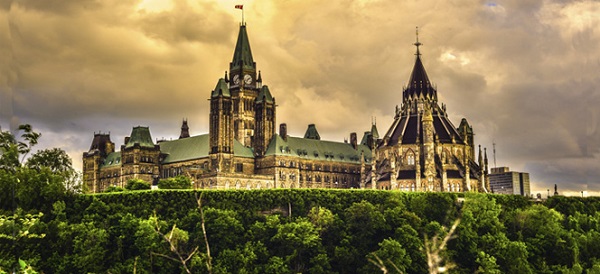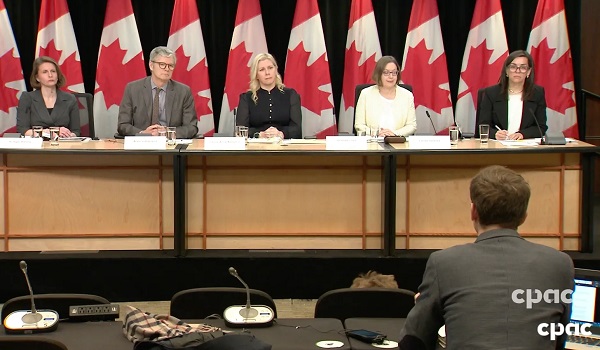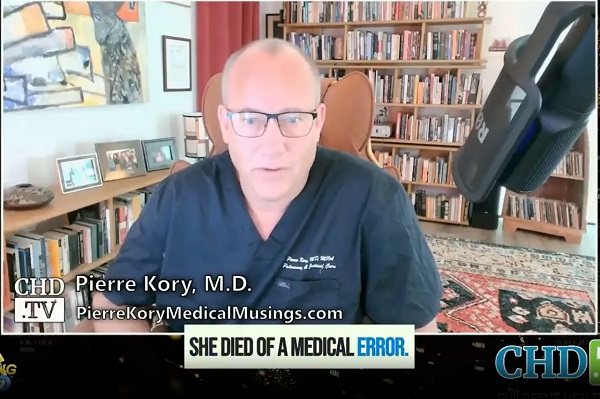Indigenous
No accounts on $7.9 million dollar ‘Truth’ Fund

From the Frontier Centre for Public Policy
The First Nation prompted an international outcry in 2021 when it announced the discovery of 215 children’s graves hidden at the Kamloops Residential School. It said remains were found using ground penetrating radar.
Cabinet at the time lowered the Peace Tower flag at half mast for 161 days, approved $3.1 million for a national Residential Schools Student Death Register and another $238.8 million for a Residential Schools Missing Children Community Support Fund.
The Department of Crown-Indigenous Relations has confirmed it spent millions to uncover the “heartbreaking truth” of unmarked Indian Residential School graves in Kamloops, B.C. No remains have been recovered to date and no accounting of what became of the $7.9 million has been disclosed.
“The community had received $7.9 million for field work, records searches and to secure the Residential School grounds,” said Carolane Gratton, spokesperson for the department. “Details of initiatives taken by Tk’emlups te Secwepemc First Nation are best directed to the community.”
The department has not released financial accounts under the Access To Information Act. The First Nation said in a statement it “continues to grieve children that are in our care and are focused on the scientific work that needs to be done” but would not discuss the $7.9 million.
The 2021 funding was to document the “heartbreaking truth,” according to a 2022 department briefing note. “Our thoughts are with survivors, their families and communities as the heartbreaking truth about Residential Schools’ unmarked burials continues to be unveiled,” said the note.
“Funding is available to support communities, survivors and their families on their healing journey through researching, locating and memorializing those children who died while attending Indian Residential Schools,” said the note Indian Residential School Sites: Unmarked Burials.
“If pressed on Tk’emlups te Secwepemc Kamloops Indian Residential School site, the Government of Canada has provided $7.9 million over two years to the Tk’emlups te Secwepemc Nation to support the community in conducting this important work,” said the note.
The First Nation prompted an international outcry in 2021 when it announced the discovery of 215 children’s graves hidden at the Kamloops Residential School. It said remains were found using ground penetrating radar.
Cabinet at the time lowered the Peace Tower flag at half mast for 161 days, approved $3.1 million for a national Residential Schools Student Death Register and another $238.8 million for a Residential Schools Missing Children Community Support Fund. The Fund expires in 2025.
“I think Canadians have seen with horror those unmarked graves across the country and realize that what happened decades ago isn’t part of our history, it is an irrefutable part of our present,” Prime Minister Justin Trudeau earlier told reporters.
No remains have been recovered at the Kamloops site to date. A Senate committee in a 2023 report described questions regarding documentation of the 215 graves as “Residential School denialism.”
“Denialism serves to distract people from the horrific consequences of Residential Schools and the realities of missing children, burials and unmarked graves,” said the Senate Indigenous peoples committee report Honouring The Children Who Never Came Home. It recommended “the Government of Canada take every action necessary to combat the rise of Residential School denialism.”
Published with kind permission from Blacklock’s Reporter. First published here.
Blacklock’s Reporter (founded October 2012) is an Ottawa-based Internet publication covering Canadian government administration.
Economy
CANADA MUST REVIVE A “PIPELINE WEST” – Indigenous Ownership and Investment in Energy Projects are Critical to Canada’s Oil Customer Diversification

From EnergyNow.Ca
Interesting events renewed discussions around pipeline projects when Alberta Premier, Daniel Smith made social media comments on Jan 21.2025 that Canada should have more nation-building projects and revive Northern Gateway.
It inspired an immediate comment from the President of the Union of BC Indian Chiefs, Grand Chief Stewart Phillip expressing interest in reviving the project. “If we don’t build that kind of infrastructure, Trump will,” Phillip said. “And there won’t be any consideration for the environment, for the rule of law… I think we can do better.”
The next day, Chief Phillip retracted the comment leaving questions about the 180-degree pivot.
Some proponents of Indigenous development, like Calvin Helin, a member of the Tsimshian Nation and Principal at INDsight Advisers, a lawyer who specializes in commercial and Indigenous law and best-selling author, thought the event raised questions about influence.
“Environmental groups have infiltrated some Indigenous organizations,” Helin said in an interview. “They managed to support a government that championed their agendas, particularly agendas involving Alberta – objectives like the coastal pipeline ban and changes to the regulatory approval system. In this era of Trump, all they’ve managed to do is to weaken Canada’s position.”
Helin stressed that in 2025, the energy industry clearly understands the mandate to deal seriously with Indigenous interests, with Indigenous leaders coming forward to support natural resource development while respecting the environment. He suggested that Indigenous inclusion and recognition at the outset is essential for energy projects in 2025 and beyond.
Back in 2018-2019, Helin proposed the Eagle Spirit Corridor a $50 -billion First Nations majority-owned Canadian four pipeline corridor after the Northern Gateway Pipeline was under consideration.
Helin had consulted early with Indigenous groups and proposed a robust natural resource corridor from Bruderheim, AB to Grassy Point, BC. The project involved the support of 32 First Nations from the outset. A variety of shared services were proposed to make the corridor more economical than a pipeline. Helin expected the project would create tens of thousands of jobs over the long term, as well as generate tax revenue and royalties, but it was killed by the federal government’s Bill C-48 tanker ban which stopped companies from using terminals along BC’s north coast to ship oil. The project was ultimately abandoned.
The Enbridge Northern Gateway Pipeline project for a twin pipeline from Bruderheim, AB, to Kitimat, BC, was also stopped by Bill C-48. Both Eagle Spirit and Northern Gateway chose the north BC coast for transportation to Asian markets for the deeper waters that could accommodate larger-capacity crude oil tankers.
The routes of the Eagle Spirit and Northern Gateway pipelines/corridors are quite similar with Eagle Spirit’s route extending a bit farther north in the final leg, as in the maps below.


Recent threats of tariffs on Canadian imports made by U.S. President Trump have stimulated calls to revive pipeline projects to tidewater, including Northern Gateway.
In direct reference to Northern Gateway, Enbridge CEO Greg Ebel has stated to media that Canada would have to designate major pipeline projects as legally required “in the national interest” before companies will consider investing again.
After the cancellation of Northern Gateway, Dale Swampy,the Indigenous leader who helped to establish the Northern Gateway Aboriginal Equity Partners group (AEP), formed the National Coalition of Chiefs(NCC), a group of pro-development First Nation Chiefs who advocate for the development of oil and gas resources in their communities.
Dale Swampy, President of the NCC says it still makes good sense to get a pipeline devoted to bitumen to the West Coast and that Canada has been “putting all its eggs in one basket” for 50 years and has been selling to just one customer while “everybody else in the oil industry, including the U.S., is getting into the global competitive market.”
The Canadian Energy Centre reports that the oil and gas industry is not going into decline over the next decade and in fact, the demand for oil and gas in emerging and developing economies will remain robust through 2050. In light of the multiple effects of U.S. tariffs, Canadian pipelines to tidewater are seen as urgent. Swampy advocates for policy change and the revival of the Northern Gateway project powered by Indigenous equity investment.
“First, we have got to get rid of the oil tanker ban (C-48),” Swampy said. “We’ve got to get more fluid regulatory processes so that we can get projects built in a reasonable timeline so that it doesn’t cost us billions more, waiting for the regular regulatory process to be complete- like TMX. You’ve also got to get the proponents back to the table. We had 31 of the 40 communities already signed on last time. I believe that we can get them signed on again.”
He continues to work with industry to develop an Indigenous-led bitumen pipeline project to the west coast. “We can get this project built if it’s led by First Nations.”
He says other Indigenous leaders are starting to realize the benefits of cooperating with natural resource development, whether it’s mining or the BC LNG projects that he says are now more widely accepted by First Nations.
Stephen Buffalo, President and CEO of the Indian Resource Council of Canada (IRC) agrees.
“I talk about ripple effects,” Buffalo said. “When Jason Kenney was Premier of Alberta, and the Trans Mountain expansion was a big discussion, he wanted to ensure that First Nations had an opportunity to be some sort of equity owner in projects. With the lack of investment capital, he created the Alberta Indigenous Opportunities Corporation with the province as a government backstop.”
Buffalo says the IRC has assembled just over $800 million in government backstop for First Nations to participate in projects which found strong proponents. And those projects are related to natural resource development. He acknowledged that some communities – some of them in BC, don’t see the big picture of what Indigenous Opportunities Corporations can allow them to do.
“You shouldn’t get in the way of others that really need access to healthcare and education and want to develop their communities. I always tell people, our land base, that we were given under the Indian Act, isn’t changing what our populations are. We need housing, and we need the infrastructure, which includes clean water.”
He sees the urgent need for First Nations to get out of poverty and alliances to develop natural resources are key.
“ When we landlock our resources, the U.S. economy seems to get better. Now we’re dependent on the U.S. We have to send our oil to the U.S. at a huge discount. Could or should we have Northern Gateway? Absolutely. Should we have Energy East? Absolutely. We’re importing oil, but we have it at home. Why do we need to import it?”
Buffalo agreed that project discussions and regulations have huge value, but the slowness of the discussion, including pushback from environmental groups that influence discussions is negatively impacting First Nation development. In the case of regulations like Bill C-59, the anti-greenwashing bill, Buffalo says it has silenced many of the members of the Indian Resource Council.
“I’m just looking after our communities,” Buffalo says, “the ones that are never written about, talked about, the ones that don’t have clean water, that don’t have adequate housing, that are lacking education foundations, that are lacking good health care. When government regulatory bodies are making decisions, they’re making decisions for those people that they don’t ever see or ever talk to.”
My discussions with Calvin Helin, Stephen Buffalo and Dale Swampy resulted in a few policy suggestions for 2025 and beyond.
- Repeal Bill C- 69 – It not only blocks all pipelines but stops mines, refineries, export plants and other energy infrastructure that First Nations want to invest in. C-69 is unconstitutional- as ruled on October 13.2023 by Canada’s top court.
- Cut Taxes in Response to U.S. Tariffs– Tax cuts on investment and energy can neutralize the cost of the tariffs with lower taxes and incentivize investment in Canadian projects. Eliminate the Carbon Tax- Carbon tax elimination has been popular with First Nation leaders who have stated the tax has put us at a strategic disadvantage to other countries.
- Repeal Bill C-59, the anti-green-washing bill, which according to Stephen Buffalo has silenced many of the members of the Indian Resource Council and Bill C-48 – the Tanker Ban.
- Greenlight LNG Plants and related infrastructure– Canada sells gas exports uniquely to the U.S. There is a strong business case for sales to Asian and European markets. In a recent Canadian Energy Ventures webcast it was revealed that Natural Gas is sold as LNG to Europe at 16X the price Canada sells its gas to the U.S. First Nations are successfully involved in Woodfibre LNG, Cedar LNG and Ksi Lisims LNG in BC.
- Cut Regulatory Delay & Speed Up Approvals – Delay undermines investor confidence that projects can be completed in reasonable timelines.
- Reconciliation– Issue clear guidelines on what constitutes meaningful consultation. Industry can treat Indigenous peoples as partners and continue to advance economic reconciliation, including equity partnerships.
Maureen McCall is an energy professional who writes on issues affecting the energy industry.
Frontier Centre for Public Policy
John Rustad’s Residential School Claim Is False And Dangerous

From the Frontier Centre for Public Policy
When politicians misrepresent facts or historical events, whether out of ignorance or political expediency, they do a disservice to the truth and public trust. On Feb. 24, 2025, B.C. Conservative Party Leader John Rustad reportedly told Global News that “more than 4,000 children did not return home” from residential schools because “those children died in residential schools.” As researcher Nina Green points out, this statement is demonstrably false and contradicts the Truth and Reconciliation Commission’s (TRC) final report.
Sadly, Rustad is not the only one making such claims. Similar statements, portrayed as facts, are repeated by politicians who should know better.
The truth, according to the TRC, is that 423 named children died on the premises of residential schools between 1867 and 2000. That is a tragedy, and we must expand our understanding of how and why these deaths occurred. To learn from tragedies, we must acknowledge and reflect on them. But to truly understand, we must accept what is true rather than bending or distorting it. Repeating the claim that “more than 4,000” children died in residential schools, as Rustad and others have uncritically reported, misrepresents reality.
The vastly inflated number, according to Green, originates from the University of Manitoba’s National Centre for Truth and Reconciliation (NCTR), which has misrepresented the data by including children who died after leaving school—in hospitals, in accidents at home, and even well into adulthood. This distortion has led to widespread misrepresentation, misleading policymakers and the public.
Why does this matter?
Canada’s history with Indigenous residential schools is deeply painful. Abuses, neglect and forced assimilation were real in many instances. However, distorting the facts about residential school deaths promotes a false narrative of genocide that does not serve justice—in fact, this false narrative undermines it. If reconciliation means anything, it must be built on truth, not contrived political narratives.
By repeating the claim that more than 4,000 children died at residential schools, Rustad is spreading falsehoods and stoking division. This figure has been used to justify claims of mass graves, leading to international headlines and widespread outrage that harm present generations of Indigenous people. Yet, nearly four years after the first claims of unmarked graves, no remains have been excavated or verified.
Rustad is not a private citizen—he is a public figure whose words carry weight. As such, he is responsible for ensuring that the information he disseminates is accurate. Rustad is failing in his duty to the public. Depending on his motivation, he contributes to a culture in which historical accuracy is sacrificed for political expediency.
Some may argue that the exact number of students who died at residential schools is not important. But truth is not negotiable. If we accept exaggerated claims in one instance, we set a dangerous pattern for historical distortions. The truth should not be ideological or political.
If Rustad is serious about Indigenous issues, he should demand transparency from the University of Manitoba and its NCTR. Instead of accepting misleading figures, he should call for the full release of the TRC records, as was promised in 2013.
Leaders like Rustad must be held accountable. Falsehoods, no matter how well-intentioned, do not advance reconciliation. They erode trust, divide Canadians, and ultimately undermine the cause they claim to support. All Canadians deserve much better.
Marco Navarro-Genie is the vice president of research at the Frontier Centre for Public Policy. With Barry Cooper, he is coauthor of Canada’s COVID: The Story of a Pandemic Moral Panic (2023).
-

 2025 Federal Election2 days ago
2025 Federal Election2 days agoJoe Tay Says He Contacted RCMP for Protection, Demands Carney Fire MP Over “Bounty” Remark
-

 2025 Federal Election2 days ago
2025 Federal Election2 days agoHong Kong-Canadian Groups Demand PM Carney Drop Liberal Candidate Over “Bounty” Remark Supporting CCP Repression
-

 2025 Federal Election2 days ago
2025 Federal Election2 days agoPoilievre To Create ‘Canada First’ National Energy Corridor
-

 2025 Federal Election2 days ago
2025 Federal Election2 days agoAlcohol tax and MP pay hike tomorrow (April 1)
-

 2025 Federal Election2 days ago
2025 Federal Election2 days agoChinese Election Interference – NDP reaction to bounty on Conservative candidate
-

 2025 Federal Election1 day ago
2025 Federal Election1 day agoChina Election Interference – Parties Received Security Briefing Days Ago as SITE Monitors Threats to Conservative Candidate Joe Tay
-

 2025 Federal Election1 day ago
2025 Federal Election1 day agoFixing Canada’s immigration system should be next government’s top priority
-

 Bruce Dowbiggin1 day ago
Bruce Dowbiggin1 day agoAre the Jays Signing Or Declining? Only Vladdy & Bo Know For Sure





